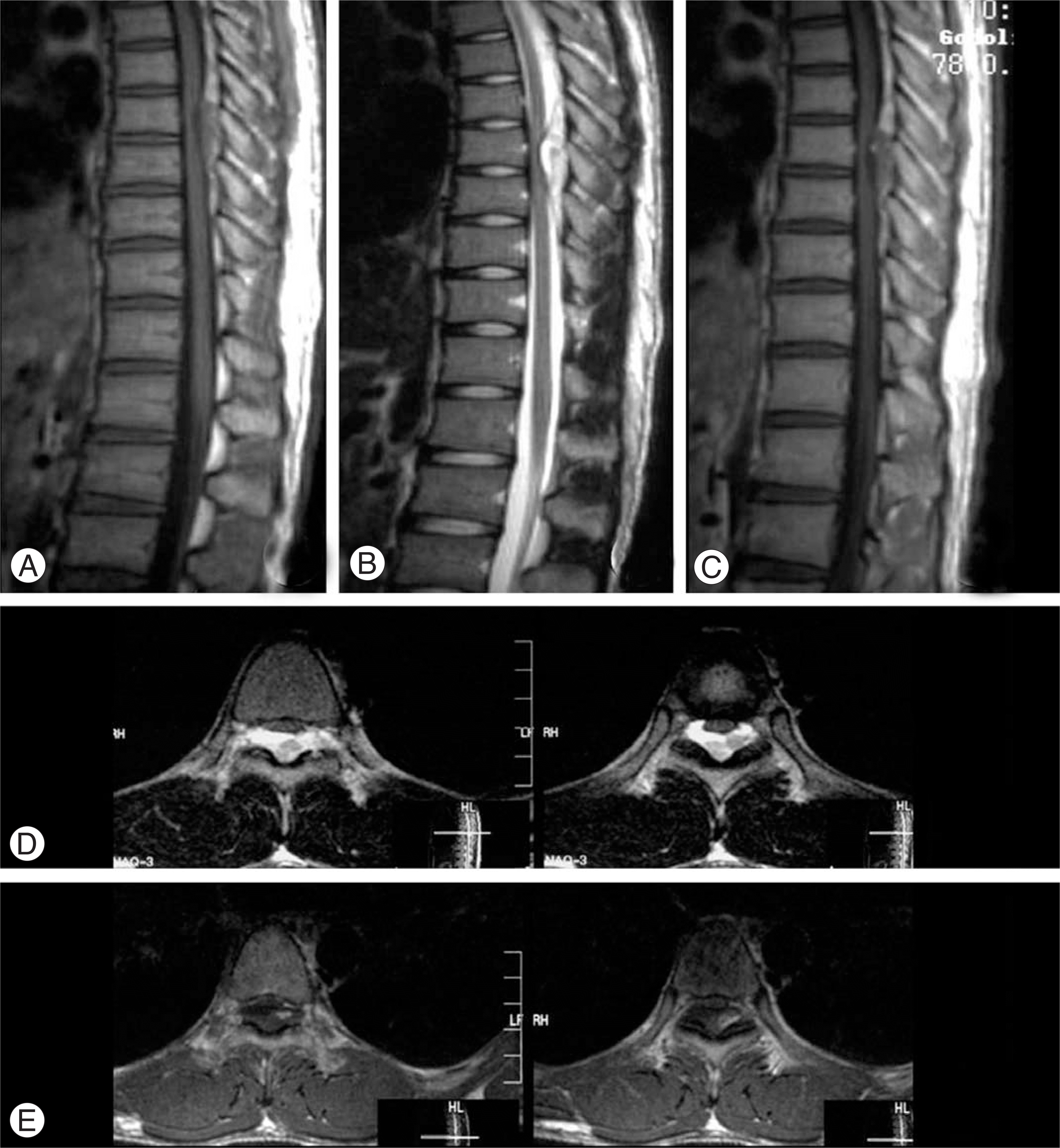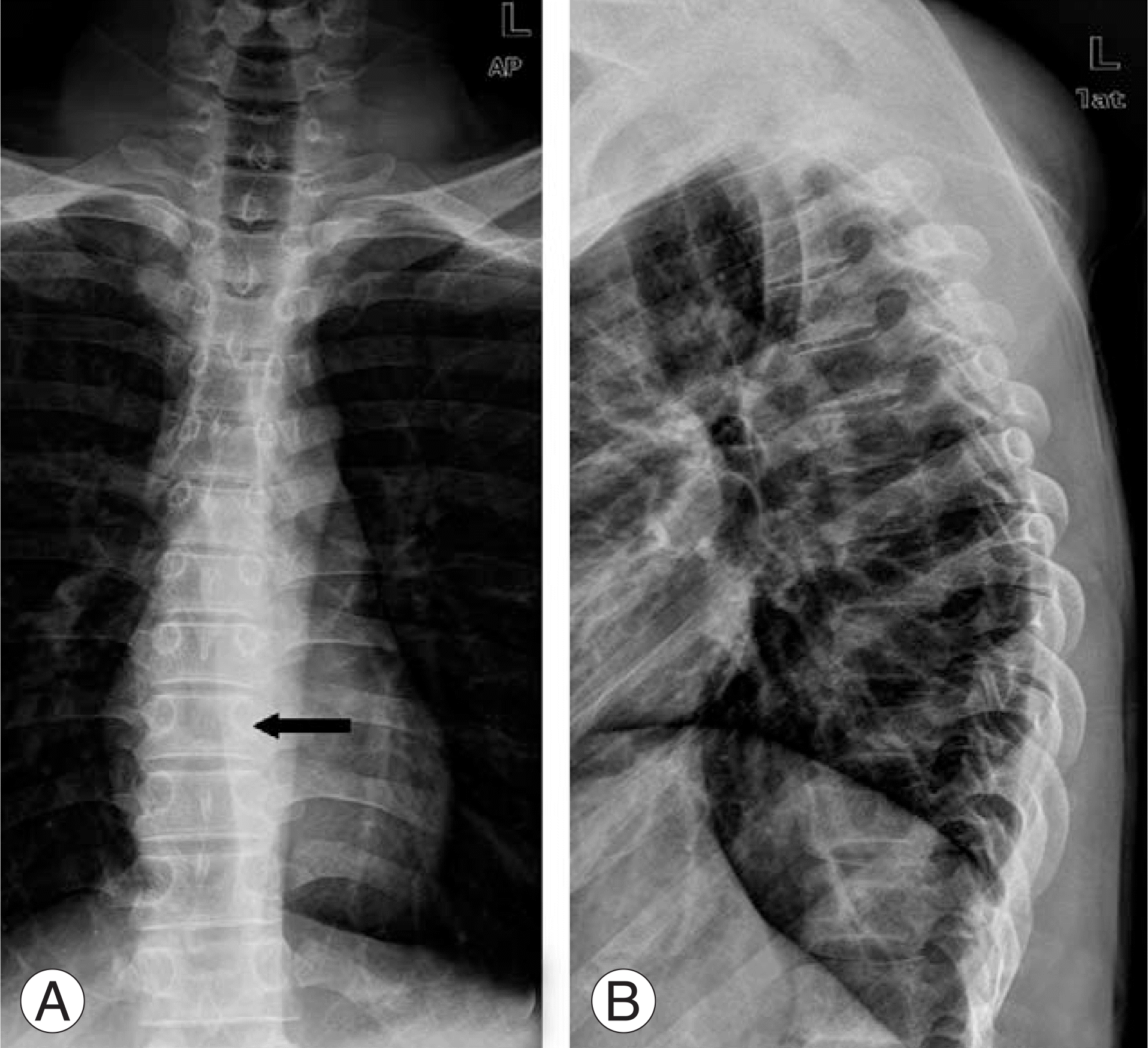Abstract
A spontaneous spinal epidural hematoma (SSEH) of the thoracic spine is a rare space-occupying disease that accompanied with severe axial pain in the spine. Because there is the possibility of a significant neurological injury such as paraplegia, SSEH requires careful diagnosis and management. A SSEH is mainly caused by a coagulating disorder or anticoagulant medication, while certain cases have shown that this disease is related with spinal inflammatory conditions. A SSEH tends to occur in patients who have risk factors for hemorrhage. However, the incidence of SSEH is quite low, and there are few domestic reports of a SSEH in young adults who are without the risk factors for hemorrhage. We encountered a 25 years old young male without a prior significant medical history and he was suffering from severe back pain and paraplegia due to a SSEH at the thoracic spine. The early diagnosis was made via MRI. We report here on a favorable clinical outcome that was achieved with immediate operative treatment, and we include a review of the relevant literature.
Go to : 
REFERENCES
1). Balkan C, Kavakli K, Karapinar D. Spinal epidural haematoma in a patient with haemophilia B. Haemophilia. 2006; 12:437–440.

2). Park HJ, Jeon JS. Spontaneous thoracic spinal epidural hematoma after use of anticoagulant. J Korean Spine Surg. 2004; 11:125–129.

3). Yun HK, Jeon SH, Cho KN, Choi JH. Thoracolumbar epidural hematoma complicated by cauda equina syndrome: Complication of systemic heparinization following epidural anesthesia: A case report. J Korean Orthop Assoc. 1998; 33:1120–1125.
4). Lee JS, Suh KT. Spontaneous lumbar spinal epidural hematoma without risk factors: A case report. J Korean Orthop Assoc. 2005; 40:1013–1016.
5). Shin SJ, Kuh SU, Cho YE. Surgical management of spontaneous spinal epidural hematoma. Eur Spine J. 2006; 15:998–1004.

6). Bo¨rm W, Mohr K, Hassepass U, Richter HP, Kast E. Spinal hematoma unrelated to previous surgery: Analysis of 15 consecutive cases treated in a single institution within a 10-year period. Spine. 2004; 29:555–561.
7). Ravi D, Dwarakanath S, Satish R, Gopal S, Venkataramana NK. Spontaneous spinal extradural hematoma. J Clin Neurosci. 2006; 13:269–272.
8). Tsai FY, Popp AJ, Waldman J. Spontaneous spinal epidural hematoma. Neuroradiology. 1975; 10:15–30.

9). Betty RM, Winston KR. Spontaneous cervical epidural hematoma. A consideration of etiology. J Neurology. 1984; 61:143–148.
10). Ravid S, Schneider S, Maytal J. Spontaneous spinal epidural hematoma: an uncommon presentation of a rare disease. Childs Nerv Syst. 2002; 18:345–347.

11). Lovblad KO, Baumgartner RW, Zambaz BD, Remon-da L, Ozdoba C, Schroth G. Nontraumatic spinal epidural hematomas, MR features. Acta Radiol. 1997; 38:8–13.
12). Foo D, Rossier AB. Preoperative neurological status in predicting surgical outcome of spinal epidural hematoma. Surg Neurol. 1981; 15:389–401.
Go to : 
 | Fig. 1.(A, B) T1 and T2-weighted sagittal image demonstrates fusiform-shaped hematoma in the spinal canal, (C) sagittal image after Gadolinium-DTPA injection shows poorly enhanced hematoma filled the spinal canal, extending from T7-T9. (D) T2 weighted axial image demonstrates spinal cord-compressing hematoma with high and intermediated signal intensity at posterior aspect of spinal cord. (E) T1 weighted enhanced axial image shows poorly enhanced mass-like lesions. |




 PDF
PDF ePub
ePub Citation
Citation Print
Print



 XML Download
XML Download